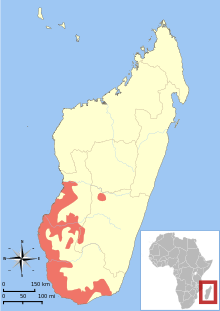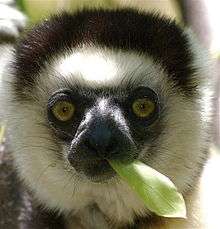Verreaux's sifaka
| Verreaux's sifaka | |
|---|---|
 | |
| Scientific classification | |
| Kingdom: | Animalia |
| Phylum: | Chordata |
| Clade: | Synapsida |
| Class: | Mammalia |
| Order: | Primates |
| Suborder: | Strepsirrhini |
| Family: | Indriidae |
| Genus: | Propithecus |
| Species: | P. verreauxi |
| Binomial name | |
| Propithecus verreauxi A. Grandidier, 1867[3] | |
 | |
| Distribution of P. verreauxi[1] | |
| Synonyms | |
| |
Verreaux's sifaka (Propithecus verreauxi), or the white sifaka, is a medium-sized primate in one of the lemur families, the Indriidae. It lives in Madagascar and can be found in a variety of habitats from rainforest to western Madagascar dry deciduous forests and dry and spiny forests. Its fur is thick and silky and generally white with brown on the sides, top of the head, and on the arms. Like all sifakas, it has a long tail that it uses as a balance when leaping from tree to tree. However, its body is so highly adapted to an arboreal existence, on the ground its only means of locomotion is hopping. The species lives in small troops which forage for food.
Four subspecies of this lemur are described. Many things are unknown about Verreaux's sifaka, so their lifespan in the wild has not been approximated, but in captivity, they generally live to up to 18 years old.
Anatomy
In adulthood, the full head and body length is between 42 and 45 cm (17 and 18 in). The tail of a fully grown Verreaux's sifaka grows to be between 56 and 60 cm (22 and 24 in) long. In weight, adult females reach 3.4 kg (7.5 lb) on average, and adult males 3.6 kg (7.9 lb).
Verreaux's sifaka has a relatively low, flat braincase. The face is broader than that of most other indriids, but its snout is reduced. This species of sifaka is also distinguished by its unique dentition. Its dental formula is 2.1.2.32.0.2.3. The upper incisors are very small and are slightly angled inward towards the gap between I1 and I2. In the mandible, Verreaux's sifaka displays the stresirhine characteristic: the toothcomb. Formed by the procumbent lower incisor and canine, the toothcomb projects past the front margin of the mouth. P. verreauxi also presents the high, shearing molar crests of a folivore, helping to shread the leaves, fruit, and flowers that it eats. Postcranially, Verreaux's sifaka has a low intermembral index that ranges from 63-66. It has a broader ribcage than most other prosimians, and has many lumbar vertebrae lending it considerable flexibility. The pelvis is high and narrow and the acetabulum is relatively shallow, also allowing for greater flexibility. Like other indriids, P. verreauxi has a short calcaneus, pointed nails, and slightly webbed hands and feet.
Diet

Verreaux's sifakas forage for food with their troop, primarily in the morning and late afternoon, so they can rest during the hottest part of the day. They are herbivores; leaves, fruit, bark and flowers are typical components of the diet. However, they are mostly folivorous (leaves represent the majority of the diet over the year, especially in the dry season) and they seem to choose food items based on quality (lower tannin content) rather than on availability.[4]
Behaviour
Verreaux's sifakas are diurnal and arboreal, and engage in sunbathing with outstretched arms and legs. They move through the trees by clinging and leaping between vertical supports. They are capable of making remarkable leaps through the trees - distances of 9–10 m are not uncommon. On the ground, they hop bipedally.[5][6] They live in family groups, or troops, of 2-12, which may consist of one male and female, or many males and females together. Group and population sex ratio can be more or less skewed toward males.[7][8] Many groups seem to be effectively harem groups with a single dominant male unrelated with resident female(s).[9] They have a home range of 2.8 to 5.0 ha, and although they are territorial, they defend food sources rather than territorial boundaries, as often boundaries overlap. Females are dominant over males, forming a matriarchal society.
Females use anogenital secretion mainly for territory demarcation whereas males seem to use specialized secretions (via anogenital and throat glands) more for sexual "advertisement" than for territorial purposes.[10][11] Males show bimorphism, by showing either a clean or stained chest, derived from throat gland secretions and smeared on surfaces by rubbing the upper part of the chest.[12] Stain-chested males engage in the most active marking, and chest staining seems to be related to testosterone levels.[13]
Males and females were found to engage in a biological market, exchanging grooming for grooming during the non-mating period, and grooming ("offered" by males) for reproductive opportunities (sexual access "offered" by females) during the mating period.[14] A study found that females copulate more with stained-chested than with clean-chested males. On the other hand, clean-chested males, with a lower scent-releasing potential, usually offer more grooming to females. This “grooming for sex” tactic allows males with a clean chest to get to copulate with females, even if at low rate.[15]
It has also been discovered that sifaka dyads often engage in post-conflict reunions after aggressive episodes: reconciliation occurs more frequently when food is not involved and for low intensity aggressions.[16] In this species play behavior persists into adulthood where it is used, especially by stranger males during the mating period, as an ice-breaking mechanism to reduce xenophobia.[17]
Reproduction
Females give birth to one infant after a gestation period of 130 days, between June and August. For the first 6–8 weeks, the infant clings to the mother's stomach, but for the following 19 weeks, it clings to her back.[18]
Ecology and Conservation status
Currently this species is considered to be Endangered by the IUCN. In the small spiny forest fragments of South Madagascar, sifaka abundance appears to be influenced by the proportion of large trees (diameter at breast height >=5 cm) and by the abundance of the plant species Allouadia procera,[19] a key species of the spiny forest habitat.[20] A long-term, large-scale demographic study of the species at Beza Mahafaly Special Reserve in southwest Madagascar found that the sifaka population there had a population growth rate of 0.98 (with confidence intervals spanning 1), suggesting that the population was not in danger of imminent extinction. However, both severe droughts and an increased annual variation in rainfall levels can depress the population growth rate.[21]
References
- 1 2 Andriaholinirina, N.; et al. (2014). "Propithecus verreauxi". IUCN Red List of Threatened Species. Version 2014.1. International Union for Conservation of Nature. Retrieved 2014-06-16.
- ↑ "Checklist of CITES Species". CITES. UNEP-WCMC. Retrieved 18 March 2015.
- ↑ Groves, C.P. (2005). Wilson, D.E.; Reeder, D.M., eds. Mammal Species of the World: A Taxonomic and Geographic Reference (3rd ed.). Baltimore: Johns Hopkins University Press. p. 121. OCLC 62265494. ISBN 0-801-88221-4.
- ↑ Norscia, I.; Carrai, V.; Borgognini-Tarli, S.M. (2006). "Influence of Dry Season and Food Quality and Quantity on Behavior and Feeding Strategy of Propithecus verreauxi in Kirindy, Madagascar". International Journal of Primatology. 27: 1001–1022. doi:10.1007/s10764-006-9056-x.
- ↑ Wunderlich R.E., Lawler R.R., Williams A.E. 2011. Field and experimental approaches to locomotor ontogeny in Propithecus verreauxi In Primate Locomotion: Linking Field and Laboratory Research. K.D. D'Aout, E.E. Vereecke (eds.) Springer Science. pp.135–154
- ↑ Lawler R.R. (2006). "Sifaka positional behavior: Ontogenetic and quantitative genetic approaches". American Journal of Physical Anthropology. 131: 261–271. doi:10.1002/ajpa.20430.
- ↑ Richard, A.F. (1985). "Social boundaries in a Malagasy prosimian, the Sifaka (Propithecus verreauxi)". International Journal of Primatology. 6: 553–568. doi:10.1007/BF02692288.
- ↑ Norscia, I.; Palagi P. (2008). "Berenty 2006: Census of Propithecus verreauxi and possible evidence of population stress.". International Journal of Primatology. 29: 1099–1115. doi:10.1007/s10764-008-9259-4.
- ↑ Kappeler, P.M.; Schäffler, L. (2007). "The lemur syndrome unresolved: extreme male reproductive skew in sifakas (Propithecus verreauxi), a sexually monomorphic primate with female dominance". Behavioral Ecology and Sociobiology. 62: 1007–1015. doi:10.1007/s00265-007-0528-6.
- ↑ Lewis, R.J. (2005). "Sex differences in scent-marking in sifaka: Mating conflict or male services?". American Journal of Physical Anthropology. 128 (2): 389–398. doi:10.1002/ajpa.20206. PMID 15795894.
- ↑ Lewis R.J. (2006). "Scent marking in Sifaka : No one function explains it all". American Journal of Primatology. 68 (6): 622–636. doi:10.1002/ajp.20256. PMID 16715510.
- ↑ Lewis R.J. & van Schaik C.P. (2007). "Bimorphism in Male Verreaux's Sifaka in the Kirindy Forest of Madagascar". International Journal of Primatology. 28: 159–182. doi:10.1007/s10764-006-9107-3.
- ↑ Lewis R.J. (2009). "Chest Staining Variation as a Signal of Testosterone Levels in Male Verreaux's Sifaka". Physiology & Behavior. 96: 586–592. doi:10.1016/j.physbeh.2008.12.020.
- ↑ Norscia, I.; Antonacci, D.; Palagi, E. (2009). Brosnan, Sarah Frances, ed. "Mating First, Mating More: Biological Market Fluctuation in a Wild Prosimian". PLoS ONE. 4 (3): e4679. doi:10.1371/journal.pone.0004679. PMC 2650411
 . PMID 19262737.
. PMID 19262737. - ↑ Dall'Olio S.; Norscia I.; Antonacci D.; Palagi E. (2012). Proulx, ed. "Sexual Signalling in Propithecus verreauxi: Male "Chest Badge" and Female Mate Choice". PLoS ONE. 7 (5): e37332. doi:10.1371/journal.pone.0037332.
- ↑ Palagi, E.; Antonacci, D.; Norscia, I. (2008). "Peacemaking on treetops: first evidence of reconciliation from a wild prosimian (Propithecus verreauxi)". Animal Behavior. 76: 737–747. doi:10.1016/j.anbehav.2008.04.016.
- ↑ Antonacci, D.; Norscia, I.; Palagi, E. (2010). Iwaniuk, Andrew, ed. "Stranger to Familiar: Wild Strepsirhines Manage Xenophobia by Playing". PLoS ONE. 5 (10): e13218. doi:10.1371/journal.pone.0013218. PMC 2951354
 . PMID 20949052.
. PMID 20949052. - ↑ Richard A.F. (1976). "Preliminary observations on the birth and development of Propithecus verreauxi to the age of six months". Primates. 17: 357–366. doi:10.1007/bf02382791.
- ↑ Norscia, I.; Palagi, E. (2011). "Fragment quality and distribution of the arboreal primate Propithecus verreauxi in the spiny forest of south Madagascar". Journal of Tropical Ecology. 27: 103–106. doi:10.1017/S0266467410000519.
- ↑ Elmqvist, T.; Pyykonen, M.; Tengo, N.; Rakotondrasoa, F.; Rabakonandrianina, E.; Radimilahy, C. (2007). Somers, Michael, ed. "Patterns of Loss and Regeneration of Tropical Dry Forest in Madagascar: The Social Institutional Context". PLoS ONE. 2(5): e403. doi:10.1371/journal.pone.0000402.
- ↑ Lawler R.R.; Caswell H.; Richard A.F.; Ratsirarson J.; Dewar R.E.; Schwartz M. (2009). "Demography of Verreaux's sifaka in a stochastic rainfall environment". Oecologia. 161: 491–504. doi:10.1007/S00442-009-1382-1.
External links
| Wikispecies has information related to: Verreaux's sifaka |
| Wikimedia Commons has media related to Propithecus verreauxi. |
- ARKive - images and movies of the Verreaux's sifaka (Propithecus verr)
- Mongabay.com - Dancing lemur attracts tourists to island of Madagascar
- BBC facts
